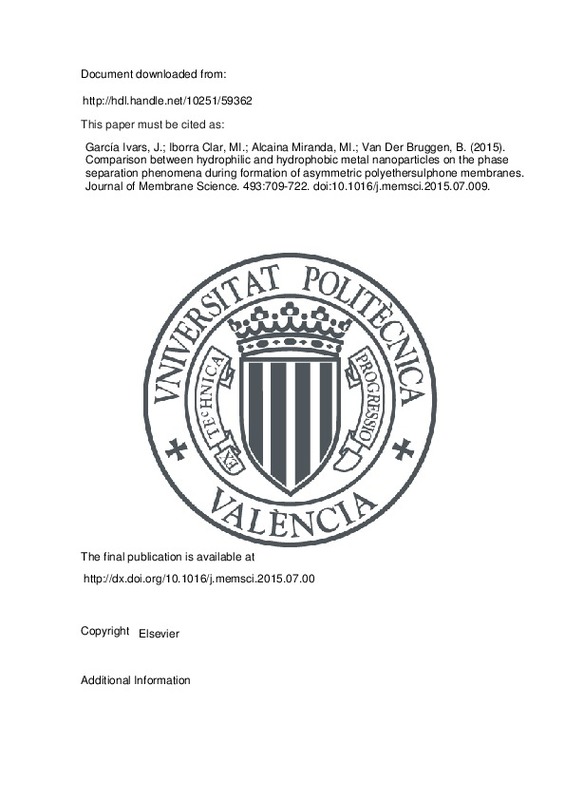JavaScript is disabled for your browser. Some features of this site may not work without it.
Buscar en RiuNet
Listar
Mi cuenta
Estadísticas
Ayuda RiuNet
Admin. UPV
Comparison between hydrophilic and hydrophobic metal nanoparticles on the phase separation phenomena during formation of asymmetric polyethersulphone membranes
Mostrar el registro sencillo del ítem
Ficheros en el ítem
| dc.contributor.author | García Ivars, Jorge
|
es_ES |
| dc.contributor.author | Iborra Clar, María Isabel
|
es_ES |
| dc.contributor.author | Alcaina Miranda, María Isabel
|
es_ES |
| dc.contributor.author | Van der Bruggen, Bart
|
es_ES |
| dc.date.accessioned | 2016-01-05T09:26:39Z | |
| dc.date.available | 2016-01-05T09:26:39Z | |
| dc.date.issued | 2015-11-01 | |
| dc.identifier.issn | 0376-7388 | |
| dc.identifier.uri | http://hdl.handle.net/10251/59362 | |
| dc.description.abstract | Inorganic nanoparticles have been applied as additive in membrane synthesis for improving different properties from the base polymer such as hydrophilicity, fouling resistance or permselectivity. To investigate the changes caused by the presence of the inorganic nanoparticles in the formation of the membrane structure, two different metallic compounds with opposite hydrophilicity were used as additives: hydrophilic zinc oxide (ZnO) and hydrophobic tungsten disulphide (WS2). For this purpose, the effect of these metal nanoparticles at ultra-low concentrations (0.05 and 0.25 wt% metal nanoparticles/polymer ratio) in the preparation of flat-sheet membranes based on polyethersulphone (PES) by immersion-precipitation method was investigated. N-methyl-2-pyrrolidone (NMP) was used as solvent. The influence of both metal nanoparticles on the characteristics and permselective properties of PES membranes was studied with microscopic observations, contact angle measurements, and filtration experiments. Although the incorporation of metal nanoparticles could turn the system into thermodynamically unstable, the demixing process during formation of membranes was slightly delayed, suppressing the macrovoid formation (remarkably using WS2). Regardless the nature of the metal nanoparticles, results showed an overall improvement in membrane hydrophilicity and permselectivity by adding metal nanoparticles compared to the control PES membrane, demonstrating that the behaviour of both metal nanoparticles at ultra-low concentrations was very similar. | es_ES |
| dc.language | Inglés | es_ES |
| dc.publisher | Elsevier | es_ES |
| dc.relation.ispartof | Journal of Membrane Science | es_ES |
| dc.rights | Reserva de todos los derechos | es_ES |
| dc.subject | Membrane synthesis | es_ES |
| dc.subject | Hydrophilicity | es_ES |
| dc.subject | Phase inversion | es_ES |
| dc.subject | Metal nanoparticles | es_ES |
| dc.subject | Filtration experiments. | es_ES |
| dc.subject.classification | INGENIERIA QUIMICA | es_ES |
| dc.title | Comparison between hydrophilic and hydrophobic metal nanoparticles on the phase separation phenomena during formation of asymmetric polyethersulphone membranes | es_ES |
| dc.type | Artículo | es_ES |
| dc.identifier.doi | 10.1016/j.memsci.2015.07.009 | |
| dc.rights.accessRights | Abierto | es_ES |
| dc.contributor.affiliation | Universitat Politècnica de València. Instituto de Seguridad Industrial, Radiofísica y Medioambiental - Institut de Seguretat Industrial, Radiofísica i Mediambiental | es_ES |
| dc.contributor.affiliation | Universitat Politècnica de València. Departamento de Ingeniería Química y Nuclear - Departament d'Enginyeria Química i Nuclear | es_ES |
| dc.description.bibliographicCitation | García Ivars, J.; Iborra Clar, MI.; Alcaina Miranda, MI.; Van Der Bruggen, B. (2015). Comparison between hydrophilic and hydrophobic metal nanoparticles on the phase separation phenomena during formation of asymmetric polyethersulphone membranes. Journal of Membrane Science. 493:709-722. doi:10.1016/j.memsci.2015.07.009 | es_ES |
| dc.description.accrualMethod | S | es_ES |
| dc.relation.publisherversion | http://dx.doi.org/10.1016/j.memsci.2015.07.00 | es_ES |
| dc.description.upvformatpinicio | 709 | es_ES |
| dc.description.upvformatpfin | 722 | es_ES |
| dc.type.version | info:eu-repo/semantics/publishedVersion | es_ES |
| dc.description.volume | 493 | es_ES |
| dc.relation.senia | 292474 | es_ES |
| dc.identifier.eissn | 1873-3123 |







![[Cerrado]](/themes/UPV/images/candado.png)

